L’Egypte a dévoilé lundi la découverte d’une cache renfermant 250 sarcophages et 150 statues de bronze dans la nécropole de Saqqara au sud du Caire, la dernière d’une série de découvertes marquantes dans la région.
Le site de Saqqara, à un peu plus de 15 kilomètres au sud des célèbres pyramides du plateau de Guizeh, est classé au patrimoine mondial de l’Unesco et est connu pour la célèbre pyramide à degrés du pharaon Djéser.
Ce monument, construit vers 2.700 avant Jésus-Christ par l’architecte Imhotep, est considéré comme l’un des plus anciens à la surface du globe.
Parmi les 150 statues découvertes dans la cache figurent une de l’architecte, également vizir et médecin. Inventeur de la construction en pierre de taille, Imhotep -qui a été déifié- a « révolutionné l’architecture » dans le monde antique, a déclaré lundi à la presse Mostafa Waziri, directeur du Conseil suprême des Antiquités. « Trouver la tombe d’Imhotep » est un des principaux objectifs de la mission archéologique qui a déjà entrepris quatre saisons de fouilles sur le site, a ajouté M. Waziri.
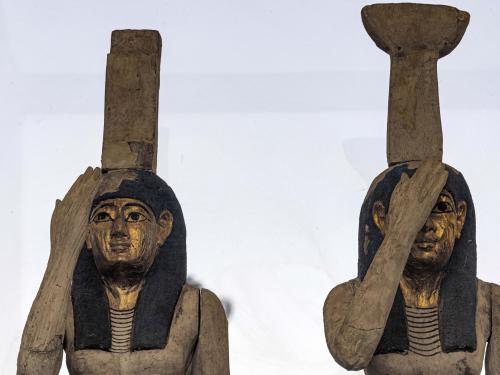
1/9
Statuettes depicting the Egyptian goddesses (L to R) Isis (Iset) and Nephthys (Nebet-Het) found in a cache dating to the Egyptian Late Period (around the fifth century BC) are displayed after their discovery by a mission headed by Egypt’s Supreme Council of Antiquities, at the Bubastian cemetery at the Saqqara necropolis, southwest of Egypt’s capital on May 30, 2022. – Egypt on May 30 unveiled a cache of 150 bronze statues depicting various gods and goddesses including « Bastet, Anubis, Osiris, Amunmeen, Isis, Nefertum and Hathor, » along with 250 sarcophagi at the Saqqara archaeological site south of Cairo, the latest in a series of discoveries in the area. (Photo by Khaled DESOUKI / AFP)
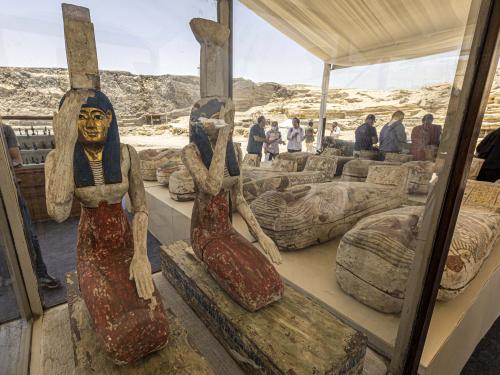
2/9
Statuettes depicting the Egyptian goddesses (L to R) Isis (Iset) and Nephthys (Nebet-Het) and other sarcophaguses found in a cache dating to the Egyptian Late Period (around the fifth century BC) are displayed after their discovery by a mission headed by Egypt’s Supreme Council of Antiquities, at the Bubastian cemetery at the Saqqara necropolis, southwest of Egypt’s capital on May 30, 2022. – Egypt on May 30 unveiled a cache of 150 bronze statues depicting various gods and goddesses including « Bastet, Anubis, Osiris, Amunmeen, Isis, Nefertum and Hathor, » along with 250 sarcophagi at the Saqqara archaeological site south of Cairo, the latest in a series of discoveries in the area. (Photo by Khaled DESOUKI / AFP)
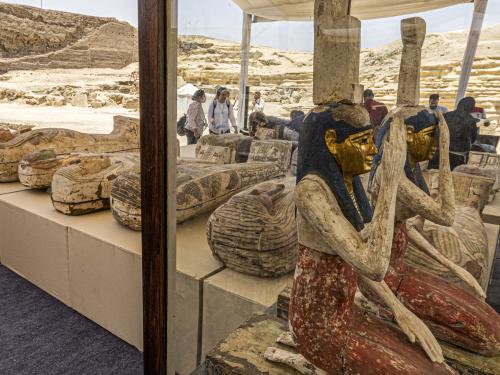
3/9
Statuettes depicting the Egyptian goddesses (L to R) Isis (Iset) and Nephthys (Nebet-Het) and other sarcophaguses found in a cache dating to the Egyptian Late Period (around the fifth century BC) are displayed after their discovery by a mission headed by Egypt’s Supreme Council of Antiquities, at the Bubastian cemetery at the Saqqara necropolis, southwest of Egypt’s capital on May 30, 2022. – Egypt on May 30 unveiled a cache of 150 bronze statues depicting various gods and goddesses including « Bastet, Anubis, Osiris, Amunmeen, Isis, Nefertum and Hathor, » along with 250 sarcophagi at the Saqqara archaeological site south of Cairo, the latest in a series of discoveries in the area. (Photo by Khaled DESOUKI / AFP)
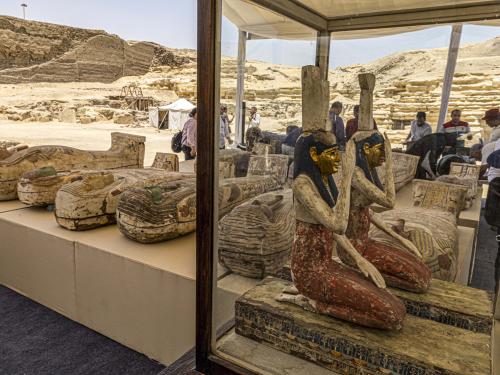
4/9
Statuettes depicting the Egyptian goddesses (L to R) Isis (Iset) and Nephthys (Nebet-Het) and other sarcophaguses found in a cache dating to the Egyptian Late Period (around the fifth century BC) are displayed after their discovery by a mission headed by Egypt’s Supreme Council of Antiquities, at the Bubastian cemetery at the Saqqara necropolis, southwest of Egypt’s capital on May 30, 2022. – Egypt on May 30 unveiled a cache of 150 bronze statues depicting various gods and goddesses including « Bastet, Anubis, Osiris, Amunmeen, Isis, Nefertum and Hathor, » along with 250 sarcophagi at the Saqqara archaeological site south of Cairo, the latest in a series of discoveries in the area. (Photo by Khaled DESOUKI / AFP)
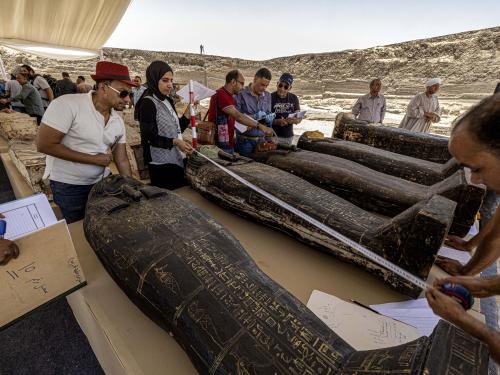
5/9
Archaeologists measure the length to register one of the sarcophaguses found in a cache dating to the Egyptian Late Period (around the fifth century BC), discovered by a mission headed by Egypt’s Supreme Council of Antiquities, at the Bubastian cemetery at the Saqqara necropolis, southwest of Egypt’s capital on May 30, 2022. – Egypt on May 30 unveiled a cache of 150 bronze statues depicting various gods and goddesses including « Bastet, Anubis, Osiris, Amunmeen, Isis, Nefertum and Hathor, » along with 250 sarcophagi at the Saqqara archaeological site south of Cairo, the latest in a series of discoveries in the area. (Photo by Khaled DESOUKI / AFP)
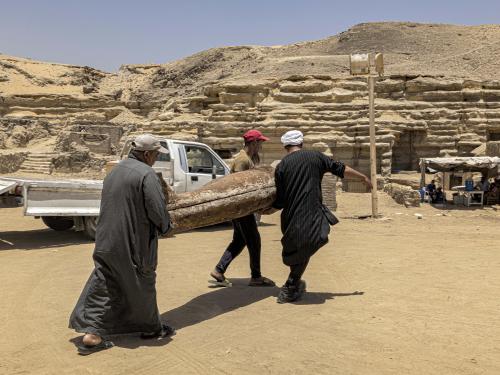
6/9
One of the sarcophaguses found in a cache dating to the Egyptian Late Period (around the fifth century BC) is transported after its discovery by a mission headed by Egypt’s Supreme Council of Antiquities, at the Bubastian cemetery at the Saqqara necropolis, southwest of Egypt’s capital on May 30, 2022. – Egypt on May 30 unveiled a cache of 150 bronze statues depicting various gods and goddesses including « Bastet, Anubis, Osiris, Amunmeen, Isis, Nefertum and Hathor, » along with 250 sarcophagi at the Saqqara archaeological site south of Cairo, the latest in a series of discoveries in the area. (Photo by Khaled DESOUKI / AFP)
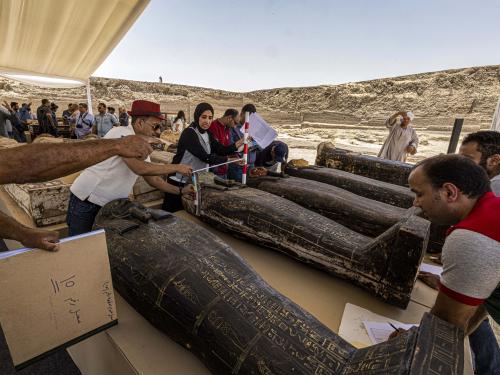
7/9
Archaeologists measure the length to register one of the sarcophaguses found in a cache dating to the Egyptian Late Period (around the fifth century BC), discovered by a mission headed by Egypt’s Supreme Council of Antiquities, at the Bubastian cemetery at the Saqqara necropolis, southwest of Egypt’s capital on May 30, 2022. – Egypt on May 30 unveiled a cache of 150 bronze statues depicting various gods and goddesses including « Bastet, Anubis, Osiris, Amunmeen, Isis, Nefertum and Hathor, » along with 250 sarcophagi at the Saqqara archaeological site south of Cairo, the latest in a series of discoveries in the area. (Photo by Khaled DESOUKI / AFP)
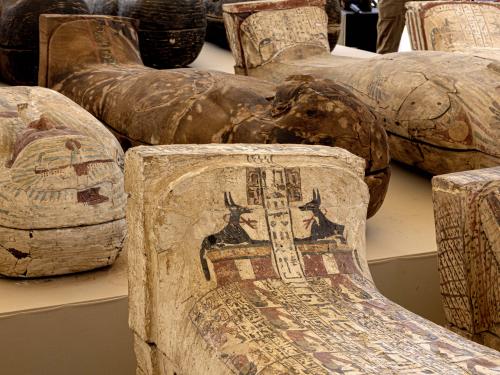
8/9
Sarcophaguses found in a cache dating to the Egyptian Late Period (around the fifth century BC) are displayed after their discovery by a mission headed by Egypt’s Supreme Council of Antiquities, at the Bubastian cemetery at the Saqqara necropolis, southwest of Egypt’s capital on May 30, 2022. – Egypt on May 30 unveiled a cache of 150 bronze statues depicting various gods and goddesses including « Bastet, Anubis, Osiris, Amunmeen, Isis, Nefertum and Hathor, » along with 250 sarcophagi at the Saqqara archaeological site south of Cairo, the latest in a series of discoveries in the area. (Photo by Khaled DESOUKI / AFP)
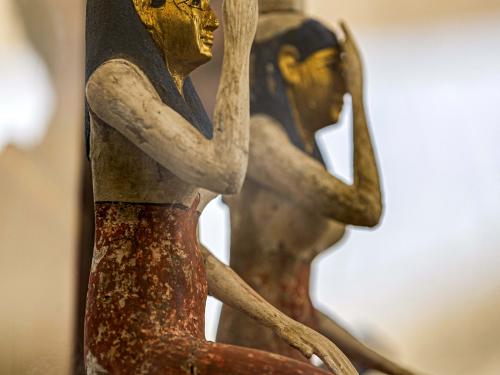
9/9
Statuettes depicting the Egyptian goddesses (L to R) Isis (Iset) and Nephthys (Nebet-Het) found in a cache dating to the Egyptian Late Period (around the fifth century BC) are displayed after their discovery by a mission headed by Egypt’s Supreme Council of Antiquities, at the Bubastian cemetery at the Saqqara necropolis, southwest of Egypt’s capital on May 30, 2022. – Egypt on May 30 unveiled a cache of 150 bronze statues depicting various gods and goddesses including « Bastet, Anubis, Osiris, Amunmeen, Isis, Nefertum and Hathor, » along with 250 sarcophagi at the Saqqara archaeological site south of Cairo, the latest in a series of discoveries in the area. (Photo by Khaled DESOUKI / AFP)

1/9
Statuettes depicting the Egyptian goddesses (L to R) Isis (Iset) and Nephthys (Nebet-Het) found in a cache dating to the Egyptian Late Period (around the fifth century BC) are displayed after their discovery by a mission headed by Egypt’s Supreme Council of Antiquities, at the Bubastian cemetery at the Saqqara necropolis, southwest of Egypt’s capital on May 30, 2022. – Egypt on May 30 unveiled a cache of 150 bronze statues depicting various gods and goddesses including « Bastet, Anubis, Osiris, Amunmeen, Isis, Nefertum and Hathor, » along with 250 sarcophagi at the Saqqara archaeological site south of Cairo, the latest in a series of discoveries in the area. (Photo by Khaled DESOUKI / AFP)

2/9
Statuettes depicting the Egyptian goddesses (L to R) Isis (Iset) and Nephthys (Nebet-Het) and other sarcophaguses found in a cache dating to the Egyptian Late Period (around the fifth century BC) are displayed after their discovery by a mission headed by Egypt’s Supreme Council of Antiquities, at the Bubastian cemetery at the Saqqara necropolis, southwest of Egypt’s capital on May 30, 2022. – Egypt on May 30 unveiled a cache of 150 bronze statues depicting various gods and goddesses including « Bastet, Anubis, Osiris, Amunmeen, Isis, Nefertum and Hathor, » along with 250 sarcophagi at the Saqqara archaeological site south of Cairo, the latest in a series of discoveries in the area. (Photo by Khaled DESOUKI / AFP)

3/9
Statuettes depicting the Egyptian goddesses (L to R) Isis (Iset) and Nephthys (Nebet-Het) and other sarcophaguses found in a cache dating to the Egyptian Late Period (around the fifth century BC) are displayed after their discovery by a mission headed by Egypt’s Supreme Council of Antiquities, at the Bubastian cemetery at the Saqqara necropolis, southwest of Egypt’s capital on May 30, 2022. – Egypt on May 30 unveiled a cache of 150 bronze statues depicting various gods and goddesses including « Bastet, Anubis, Osiris, Amunmeen, Isis, Nefertum and Hathor, » along with 250 sarcophagi at the Saqqara archaeological site south of Cairo, the latest in a series of discoveries in the area. (Photo by Khaled DESOUKI / AFP)

4/9
Statuettes depicting the Egyptian goddesses (L to R) Isis (Iset) and Nephthys (Nebet-Het) and other sarcophaguses found in a cache dating to the Egyptian Late Period (around the fifth century BC) are displayed after their discovery by a mission headed by Egypt’s Supreme Council of Antiquities, at the Bubastian cemetery at the Saqqara necropolis, southwest of Egypt’s capital on May 30, 2022. – Egypt on May 30 unveiled a cache of 150 bronze statues depicting various gods and goddesses including « Bastet, Anubis, Osiris, Amunmeen, Isis, Nefertum and Hathor, » along with 250 sarcophagi at the Saqqara archaeological site south of Cairo, the latest in a series of discoveries in the area. (Photo by Khaled DESOUKI / AFP)

5/9
Archaeologists measure the length to register one of the sarcophaguses found in a cache dating to the Egyptian Late Period (around the fifth century BC), discovered by a mission headed by Egypt’s Supreme Council of Antiquities, at the Bubastian cemetery at the Saqqara necropolis, southwest of Egypt’s capital on May 30, 2022. – Egypt on May 30 unveiled a cache of 150 bronze statues depicting various gods and goddesses including « Bastet, Anubis, Osiris, Amunmeen, Isis, Nefertum and Hathor, » along with 250 sarcophagi at the Saqqara archaeological site south of Cairo, the latest in a series of discoveries in the area. (Photo by Khaled DESOUKI / AFP)

6/9
One of the sarcophaguses found in a cache dating to the Egyptian Late Period (around the fifth century BC) is transported after its discovery by a mission headed by Egypt’s Supreme Council of Antiquities, at the Bubastian cemetery at the Saqqara necropolis, southwest of Egypt’s capital on May 30, 2022. – Egypt on May 30 unveiled a cache of 150 bronze statues depicting various gods and goddesses including « Bastet, Anubis, Osiris, Amunmeen, Isis, Nefertum and Hathor, » along with 250 sarcophagi at the Saqqara archaeological site south of Cairo, the latest in a series of discoveries in the area. (Photo by Khaled DESOUKI / AFP)

7/9
Archaeologists measure the length to register one of the sarcophaguses found in a cache dating to the Egyptian Late Period (around the fifth century BC), discovered by a mission headed by Egypt’s Supreme Council of Antiquities, at the Bubastian cemetery at the Saqqara necropolis, southwest of Egypt’s capital on May 30, 2022. – Egypt on May 30 unveiled a cache of 150 bronze statues depicting various gods and goddesses including « Bastet, Anubis, Osiris, Amunmeen, Isis, Nefertum and Hathor, » along with 250 sarcophagi at the Saqqara archaeological site south of Cairo, the latest in a series of discoveries in the area. (Photo by Khaled DESOUKI / AFP)

8/9
Sarcophaguses found in a cache dating to the Egyptian Late Period (around the fifth century BC) are displayed after their discovery by a mission headed by Egypt’s Supreme Council of Antiquities, at the Bubastian cemetery at the Saqqara necropolis, southwest of Egypt’s capital on May 30, 2022. – Egypt on May 30 unveiled a cache of 150 bronze statues depicting various gods and goddesses including « Bastet, Anubis, Osiris, Amunmeen, Isis, Nefertum and Hathor, » along with 250 sarcophagi at the Saqqara archaeological site south of Cairo, the latest in a series of discoveries in the area. (Photo by Khaled DESOUKI / AFP)

9/9
Statuettes depicting the Egyptian goddesses (L to R) Isis (Iset) and Nephthys (Nebet-Het) found in a cache dating to the Egyptian Late Period (around the fifth century BC) are displayed after their discovery by a mission headed by Egypt’s Supreme Council of Antiquities, at the Bubastian cemetery at the Saqqara necropolis, southwest of Egypt’s capital on May 30, 2022. – Egypt on May 30 unveiled a cache of 150 bronze statues depicting various gods and goddesses including « Bastet, Anubis, Osiris, Amunmeen, Isis, Nefertum and Hathor, » along with 250 sarcophagi at the Saqqara archaeological site south of Cairo, the latest in a series of discoveries in the area. (Photo by Khaled DESOUKI / AFP)









Outre la statue d’Imhotep, d’autres en bronze représentant les divinités du panthéon égyptien « Osiris, Isis, Hathor, Amon-Min, Néfertoum et Anubis » ont été mises au jour, a indiqué le ministère du Tourisme et des Antiquités dans un communiqué.
Et « 250 sarcophages en bois renfermant des momies » datant du Ve siècle avant Jésus-Christ, ont également été découverts, a ajouté M. Waziri.
Dans l’un d’eux, un papyrus « intact » et « scellé » trouvé par les archéologues a été immédiatement transféré au laboratoire du musée égyptien de la place Tahrir, au Caire, pour y être restauré et analysé. Estimé long de neuf mètres, il renferme certainement des chapitres du Livre des morts, selon le directeur.
M. Waziri a indiqué que les sarcophages seraient déplacés vers le nouveau « Grand musée égyptien », près du plateau de Gizeh, que les autorités égyptiennes espèrent inaugurer cette année après de multiples retards.
En janvier 2021, l’Egypte avait déjà dévoilé de nouveaux « trésors » archéologiques à Saqqara, dont une cinquantaine de sarcophages du Nouvel Empire vieux de plus de 3.000 ans, les autorités assurant qu’ils permettaient de « réécrire l’histoire » de cette période.
Le Caire compte sur ces nouvelles découvertes pour relancer le tourisme, frappé de plein fouet par le Covid-19. Ce secteur qui emploie deux millions de personnes et génère plus de 10% du PIB est en berne depuis le Printemps arabe en 2011.
